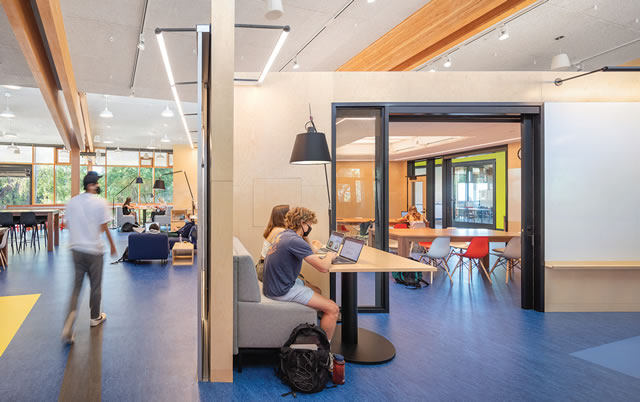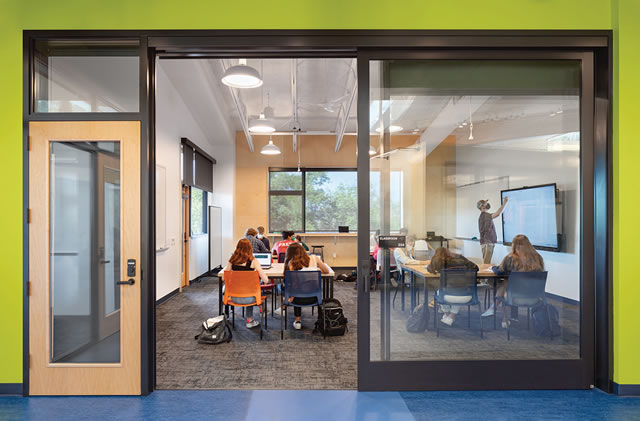Opening the Doors to Evidence-Based Design In Ojai, California
In 2021, the Thacher School,
located in Ojai, Calif., opened the doors to
its project-based learning hub. The space
was designed to support a multidisciplinary
learning environment with collaborative
common areas and classrooms that
provide greater flexibility in their use. One
of the project’s goals was to aid student learning through evidence-based design,
which roots decisions about the built environment
in research to optimize occupant
experience. While the hub incorporates
several elements to achieve this goal, the
building’s eight full-lite, oversized interior
sliding glass doors proved to be key.

COURTESY OF ALEX NYE PHOTOGRAPHY
These doors range in from 97.5 inches
to 120 inches in height and from 62.125
inches to 79.25 inches in width. All eight
doors and their assemblies hold expansive
glass lites with sturdy, impact-resistant
aluminum framing. They promote a fluid
classroom layout, balance visual connectivity
with acoustic privacy and contribute
ample daylight and visual connectivity—all of which are researched tenets
of evidence-based design. As such, they
help create an optimal learning environment
for Thacher’s students.
Although the specifics of the project-based learning hub are particular to
Thacher, they bely general benefits. Each
architectural element of a classroom or
school holds the potential to contribute to
a student’s ability to learn within the space.
This is why careful consideration of building
design can positively impact student
success. By examining how interior sliding
doors helped support evidence-based design
at Thacher, architects and institutions
can extract the concept’s basic premises
and incorporate them into their spaces to
help students reach their full potential.
Flexible Layout
Can Contribute
to Student Success
While research on the benefits of flexible
spaces in educational settings is scarce, the
studies available seem to indicate that flexibility
in classroom design can boost academic
performance. A 2016 study of U.K.
primary schools conducted by Barrett,
Davies, Zhang and Barrett implies that
environmental parameters affect learning
in different ways. Lighting and individualization
most impact math studies. Connection
to others and links to nature most
benefit reading and writing, respectively.
Accordingly, it would seem to follow that
when classrooms can adapt their space to
accentuate these parameters based on subject,
they could potentially increase student
success rates across the board.
Further building the case, Mark Fehlandt’s
2017 study suggests that flexible
classroom design helps educators implement
modern teaching practices to facilitate
active student learning. In the research,
flexible classroom layout did not
directly contribute to student achievement.
Instead, it helped teachers shift
their pedagogy to engage students more
effectively. In either study, flexible layout
seems to have an effect, direct or indirect,
on student learning and so should be a
consideration when creating classrooms.
In the case of the Thacher School, Alayna
Fraser, from Blackbird Architects (the
firm behind the hub’s design), addressed
the vital role flexibility played in designing
an optimal learning environment. Fraser noted the oversized sliding doors
“allow adjacent rooms to function nearly
as one space rather than two—adding to
the flexible use of the building” and “can
easily be opened when activities benefit
from connectivity to adjacent spaces or remain
closed, providing excellent acoustic
privacy when needed.” For these reasons,
sliding doors allow educators to change
the layout of their classrooms to provide
environments that support student success
no matter the subject.
Further, these doors enhance the flexibility
of the entire hub. Students walking
through the learning hub can peek into any
classroom, whether the doors are closed or
opened, and glimpse the lesson being taught. Those inside the classroom can also look out and see students
collaborating on large whiteboards and laptops. The ability
for students to see multiple modes of learning happening simultaneously
helps establish connections between subjects and projects
to support student success. The door design ensures both faculty
and students can approach a lesson in a way that is most conducive
to the material itself and the learning style of the student.

COURTESY OF ALEX NYE PHOTOGRAPHY
Sliding Doors Balance Visual
Connectivity and Acoustic Privacy
It is also important that educational settings provide students
with quiet environments for concentrated learning. Building on
past research, Dockrell and Shield studied the impact of noise
on academic performance in 2006. Students were randomly assigned
to varying levels of noise conditions (from quiet to babble
plus environmental noise). The analyses were controlled for
ability. The results suggest that in general noise has a significant
and negative effect on both performance and speed of processing
a task. Further, students with special educational needs were
negatively affected in a different manner than their peers. These
results were in line with previous studies, which, when taken
together, suggest that acoustic privacy can have a substantial
impact on student success rates.
Supporting the need for acoustically isolated spaces, the oversized
sliding door systems in Thacher’s building were specified
with perimeter acoustic jamb gaskets and drop-down bottom
seals to provide a Noise Isolation Class (NIC) rating of up to 39.
This meant the door assemblies reduced surrounding classroom
noise by 39 decibels—effectively rendering sounds equal to average
freeway traffic to the level of a soft whisper. As a result, they
minimize noise from adjacent areas to provide students with a
distraction-free learning environment. Additionally, these doors
have a soft-close dampening system that reduces closing noise.
While all students benefit from acoustically isolated spaces,
it is important to note the increased effect noise can have
on students with hearing loss and/or students with attention
deficits or autism. For students with hearing loss, background
noise can reduce their ability to comprehend class lessons and
assignments, limiting their academic achievement. Likewise,
background noise can heighten sensory processing challenges
(which are common for those with attention deficits and/or
autism). This limits the ability for neurodivergent students to
achieve their academic potential. For these reasons, doors that
provide premium acoustic performance can not only help educational
environments support student learning in general but
can also support a more accessible learning space.
Large Glass Lites Support
Daylighting Goals
In 1999, the Herschong Mahone Group conducted one of the first
evidence-based design studies by examining the effects of daylight
on more than 2,000 classrooms in California, Washington
and Colorado. The data indicate students with the most classroom
daylighting progressed 20 percent faster on math tests and 26 percent
on reading tests in one year than those with the least. These
findings are reported to be consistent regardless of curricula or
teaching styles. They were duplicated in a 2002 study by Edwards & Torcelli and a 2008 study by Tanner. Furthermore, according to
a study by The National Center for Education Statistics, 16 – 28
percent of schools fail to provide a satisfactory amount of natural
lighting to their students. Finding efficient ways to improve access
to daylight is vital to evidence-based design.
With such evidence behind the benefits of access to daylight in
schools, it follows that the Thacher School would desire to increase
natural light within its project-based learning hub. The building’s
exterior features an extensive amount of glazing that floods the
common areas with natural light. Drawing this light into the hub’s
interior, the oversized, full-lite sliding doors help maximize the
classrooms’ access to daylight. In fact, some of the doors within the
hub are so massive they take up the vast majority of a wall. Because
they were specified with transparent sidelites and transoms, as well
as full-lites, they leave few barriers to natural light. When used in
conjunction with other architectural elements, sliding doors can
help educational settings meet and exceed daylighting goals.
Improving Student Success
with Well-Designed Doors
The doors used in Thacher’s project-based learning hub were customized
for the school, so they present specific benefits that are
particular to the building. However, they also generally support
researched tenets of evidence-based design in classrooms. As such,
they exemplify how well-chosen architectural features can potentially
enhance student learning outcomes. While door specifications
can vary greatly by school, architects and administrators can
support academic success by considering how door design contributes
to evidence-based design by providing access to daylight, flexible
layout and a balance of visual connection and acoustic privacy.
This article originally appeared in the Summer 2022 issue of Spaces4Learning.